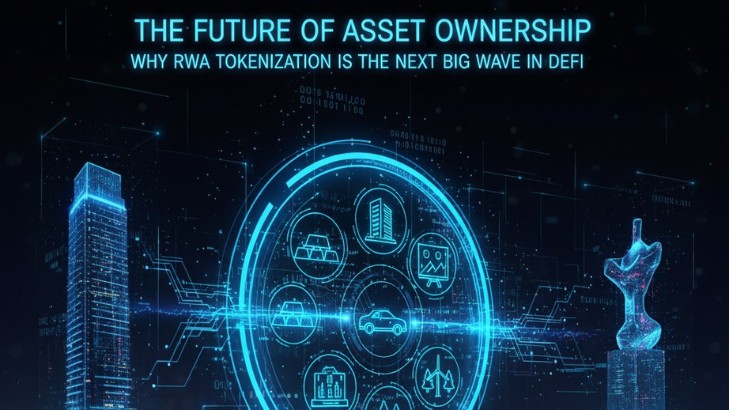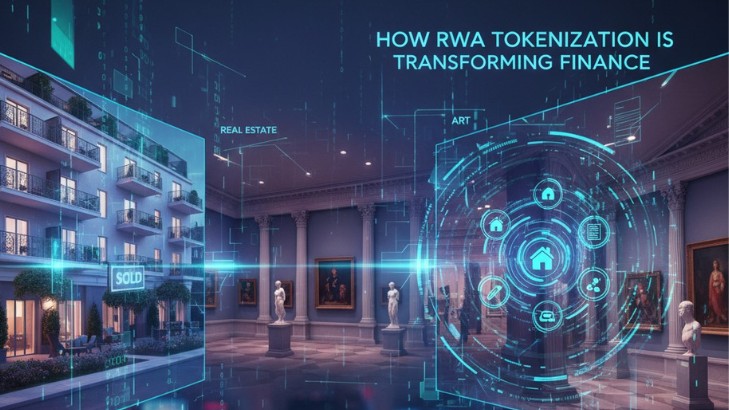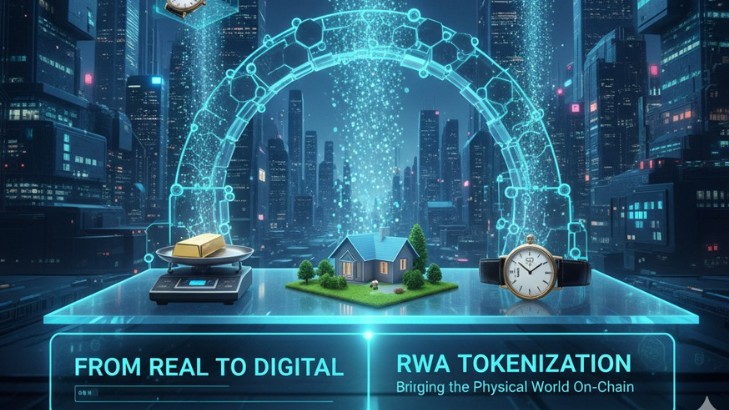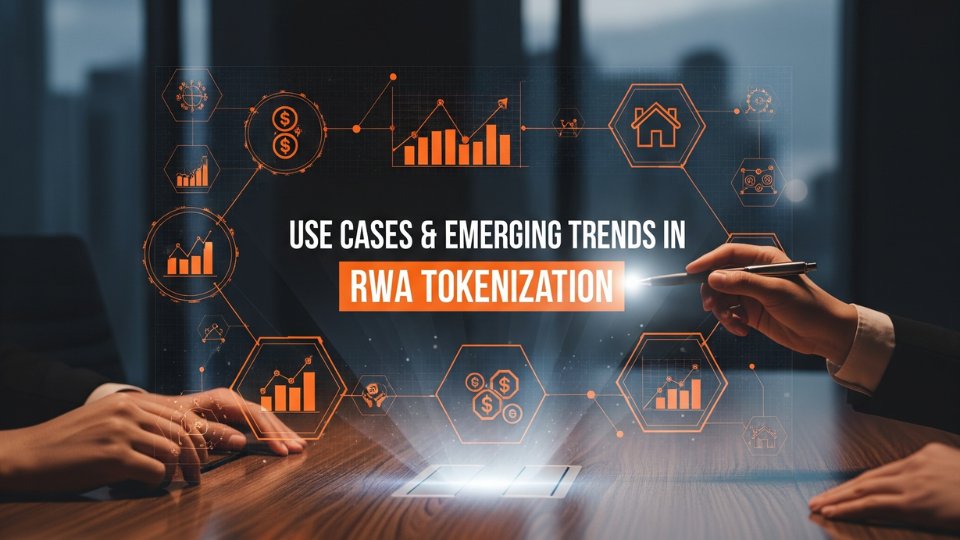The Future of Asset Ownership: Why RWA Tokenization Is the Next Big Wave in DeFi
October 7, 2025



In the evolving landscape of finance, few innovations have stirred as much interest, promise, and debate as tokenization of real-world assets (RWAs). As decentralized finance (DeFi) grows beyond lending, swapping, and yield farming, it is increasingly being seen as a bridge to the more established world of traditional assets—real estate, commodities, bonds, art, and beyond. The idea that these physical or contract-based assets can be represented on a blockchain, fractionalized, made tradeable, usable as collateral, or embedded into novel financial products is no longer speculative. It’s rapidly becoming reality. As institutions, protocols, and regulators engage seriously, the question is: why is RWA tokenization likely to be one of the next large waves for DeFi, and how will it reshape ownership, value creation, risk, and access in global finance?
This blog post explores what drives this transition, how RWAs are being integrated into DeFi already, the benefits and challenges of the shift, real-world examples, the outlook ahead, and what needs to happen for this wave to fully crest. If you are an investor, developer, regulator, or simply curious about the future of finance, understanding RWA tokenization within DeFi is essential.
What Is RWA Tokenization in the Context of DeFi
To understand why RWA tokenization matters in DeFi’s future, one must first clarify what the term means in practice. At its core, tokenization is creating a digital representation (a token) on a blockchain that corresponds to a right, ownership, claim, or cash-flow tied to a physical or off-chain asset. DeFi, which has historically dealt mostly with crypto native assets (ETH, stablecoins, governance tokens, etc.), gains when it can incorporate these tokenized real-world assets into its operations—whether for collateral, investment, yield, or composability.
In DeFi, tokenized RWAs may take several forms: bonds, treasuries, loans, invoices, real estate properties, property income streams, or even art pieces. They may be fractionally owned so that many smaller investors share in an asset’s income or appreciation. They may be used as collateral to borrow, to generate yield, or to back stablecoins. When these tokens adhere to standards and are integrated in protocols, they gain the “programmable” nature of DeFi: automated payments, liquidation rules, governance, transparent ledgers, all with fewer intermediaries.
Why It’s Poised to Be the Next Big Wave
Bridging DeFi and TradFi
One major impetus is that RWA tokenization forms a natural bridge between DeFi and traditional finance (TradFi). DeFi today attracts participants who are comfortable with crypto volatility, smart contracts, and on-chain risk. But much of global capital remains tied up in off-chain, illiquid assets. For DeFi to grow materially in scale and stability, it needs to tap into that capital. Tokenization allows capital from pensions, asset managers, and institutional investors to flow into on-chain environments with claims to real assets.
Protocols like MakerDAO are already doing this: Maker holds real-world assets (such as U.S. Treasury bonds) as part of its collateral backing for its stablecoin DAI. This provides more stable, predictable yields and bolsters the robustness of DeFi by diversifying collateral beyond volatile cryptocurrencies.
Demand for Yield Outside Crypto Volatility
Crypto markets have historically offered high yields, but also high risk and high volatility. Many investors becoming burned by sudden crashes or regulatory actions are looking for more stable, less correlated returns. RWAs offer assets whose returns are tied to real economic activity—rent from real estate, interest from bonds or loans, income from infrastructure or commodities. These returns are often more predictable. Integrating RWAs into DeFi allows these return streams to be plugged into yield-generating protocols, giving users safer “anchors” alongside riskier crypto assets.
Liquidity for Previously Illiquid Assets
A long-standing challenge in finance is illiquidity—the inability to easily buy or sell ownership of certain asset classes. Real estate, fine art, private credit, and many other RWAs are traditionally hard to convert into cash rapidly, especially without heavy transaction costs. Tokenization changes this. Fractional ownership and tradeable tokens enable markets where small parts of assets can be bought and sold quickly, with lower friction. Over time, this can reduce bid-ask spreads, encourage price discovery, and allow capital to move more efficiently across markets.
Composability and Innovation
DeFi’s strength lies in composability: the ability to mix and match protocols, assets, and financial primitives. When RWAs are tokenized in standardized ways, they can be plugged into lending protocols, used as collateral pools, bundled into diversified funds, synthetized, or integrated with derivatives. This opens possibilities for exotic financial products: for example, real estate tokens used as collateral for a decentralized loan, or commodity tokens used to collateralize stablecoins. Composability also encourages the creation of new risk-management tools, insurance, indexed products, and governance innovations. As the infrastructure matures, these experiments are likely to accelerate.
Institutional Participation
A final driver is that institutions—banks, asset managers, pension funds—are increasingly exploring or actively participating in tokenization. Their involvement brings large capital, risk management practices, and regulatory demands, which in turn help build standards, transparency, and credibility in the space. Protocols that successfully comply with regulation and deliver safe/legal tokenization are more likely to attract this capital, generating virtuous cycles of adoption. MakerDAO’s RWA portfolio is one concrete example; other platforms like Centrifuge are facilitating real-world debt financing and gaining attention.
How RWAs Are Already Being Integrated Into DeFi
Protocols Using RWAs as Collateral
MakerDAO is currently one of the most prominent examples of a protocol that uses real-world assets as collateral. The protocol has diversified beyond volatile crypto collateral to include holdings like U.S. Treasury bills. This gives the stablecoin DAI greater backing and allows the protocol to generate more stable yield from traditional finance.
Other DeFi lending and credit protocols—such as TrueFi, Goldfinch, Maple Finance—are using tokenized debt or loan receivables, often from off-chain sources, to provide credit in a way that bridges DeFi capital with real economy needs. These platforms assess off-chain risk, governance, legal structure, then issue claims or tokens tied to that credit, which investors can buy.
Tokenized Financial Assets and Treasuries
Some platforms allow tokenized treasuries and bonds to be held on chain, traded, or used as collateral. These are appealing because treasuries are already well understood, legally clear, and carry lower risk than many other RWAs. Their tokenization helps in bringing stable, low-risk yield into DeFi ecosystems.
Marketplaces and Protocols for RWA Lending
Protocols like Centrifuge have designed systems where businesses or originators can bring off-chain assets—such as invoices, real estate cash flows, or private debt—and convert them into on-chain debt pools. Investors then fund those pools and receive returns based on how the underlying off-chain assets perform. These platforms serve two sides: those needing financing and those seeking more stable, real asset-backed yield.
Performance and Investor Interest
Recent data shows that RWA-oriented protocols have in some cases outperformed many “pure” DeFi blue-chip tokens in terms of returns or stability. That has drawn investor attention, not just for speculation but for long-term value. The increased interest also pushes up the total value locked (TVL) in RWA protocols, although liquidity remains less than that in many pure crypto DeFi markets.
Key Advantages of RWA Tokenization in DeFi
Reduced Volatility and Risk Diversification
Because many RWAs are backed by income streams, contracts, or physical value, they tend to exhibit lower volatility than many crypto assets. When integrated into DeFi, they can help reduce portfolio risk, provide stability in systemic downturns, and serve as hedges. For example, stablecoins backed by RWAs or lending protocols that use RWAs as collateral may be less exposed to the high swings typical in crypto markets.
New Yield Sources
DeFi has been largely dependent on crypto native yield sources: staking, liquidity provision, yield farming. These have often been limited by market cycles, regulatory risk, or token inflation. With RWA tokenization, yield can come from rents, interest payments, dividends, or contractually fixed returns. This opens up more predictable return streams, and makes DeFi more appealing for conservative and institutional investors.
Lower Costs and Improved Efficiency
Tokenization can reduce the number of intermediaries involved in traditional finance processes such as property deed registration, bond issuance, auditing, settlement, and custody. Smart contracts and blockchain can automate or simplify many operational steps: ownership transfer, income distribution, compliance, and reporting. These efficiency gains can reduce time, friction, and cost.
Enabling Financial Inclusion
Since tokenization allows fractional ownership, people with smaller amounts of capital can invest in assets that were previously only available to high-net-worth individuals or institutions. This opens access to real estate, private credit, infrastructure, or art from any part of the world (where regulatory frameworks allow). DeFi platforms can thus broaden the investor base, increase participation, and bring capital to underserved regions and asset owners.
Cross-Border Capital Flows
Blockchain is inherently borderless. Tokenized assets can be owned, transferred, and traded across borders (subject to regulatory compliance), enabling global participation. For example, an investor in Asia might hold a fraction of a U.S. real estate property or an African infrastructure project, enabling diaspora investment or global portfolio diversification.
Challenges and Risks
Legal, Regulatory, and Compliance Hurdles
The primary obstacle for RWA tokenization remains legal enforceability. Tokens must map to legal rights, ownership, contracts, or cash flows in the real world. Local laws regarding property, securities, trust, and fiduciary obligations vary wildly. Regulatory clarity is often missing or in flux. Without clear frameworks, tokenized assets may carry risks of disputed ownership, invalid contracts, or non-recognition under law.
Regulators in many jurisdictions are still trying to figure out how to treat tokenized securities, identity requirements, cross-border trading, taxes, and disclosure obligations. Some places have paused or restricted RWA projects due to concerns over investor protection or regulatory oversight.
Custody, Verifiability, and Asset Linkage
If a token claims to represent a physical asset, proper custody, insurance, and proof of existence are critical. For artworks, buildings, or commodities, this means secure storage, verification of condition, title, and chain of ownership. If those linkages are weak, fraud, disputes, or loss becomes possible. DeFi users must trust off-chain legal and physical systems as much as on-chain mechanisms.
Oracles, Data, and Trust
Smart contracts often rely on external data (rent rolls, occupancy rates, interest payments, default events). Oracles feed this data to the blockchain. If oracles fail, are manipulated, or are not transparent, the whole system can break. Thus, robust, reliable, and auditable data feeds are required. Trust here is not just about technology; it’s also about reputation, transparency, and legal recourse.
Liquidity and Market Depth
Even where tokenized RWAs exist, secondary markets for them are often illiquid. Fractional ownership helps, but if few participants trade or if there are transfer restrictions (legal, identity, jurisdictional), tokens may still get “stuck” or hard to sell. Liquidity providers, market makers, and exchanges will need to develop, but these are complex to build for RWAs due to legal risk and uncertainty.
Complexity, Costs, and Operational Overhead
While tokenization reduces some costs and friction, it also introduces new dimensions of complexity. Legal structuring (SPVs, trusts), investor verification (KYC/AML), audits, custody, insurance, and compliance add cost. For smaller assets, the overhead may make tokenization uneconomic. Protocols and platforms must scale these operations and develop standard practices to bring down cost.
Real-World Cases & Emerging Protocols
MakerDAO and DAI
MakerDAO’s incorporation of RWAs into its collateral base is one of the clearest examples of how DeFi can evolve. By holding U.S. Treasuries and other real-world collateral, MakerDAO strengthens the stability of DAI, mitigates some of the weaknesses that pure crypto collateralized systems suffer, and offers more predictable revenue streams. This approach reflects how DeFi is trying to grow up: not merely leveraging volatile digital assets, but integrating anchors in traditional systems.
Centrifuge
Centrifuge has built a marketplace for tokenized real-world debt and other assets, allowing businesses to issue debt on chain via asset pools, while investors fund those pools. The protocol connects asset originators (who have off-chain assets) with on-chain liquidity, creating more efficient financing for small and medium enterprises. Its Tinlake system is a practical tool for this kind of integration.
Ondo Finance and Others in Tokenized Treasuries
Ondo Finance is another example of a DeFi platform that enables stablecoin holders or investors to participate in tokenized treasuries or bond-like instruments managed by traditional asset managers. These functions allow DeFi participants to access yield from bond markets without needing to invest directly in those off-chain systems themselves.
Goldfinch, TrueFi, Maple
These protocols specialize in credit or lending markets involving tokenized or semi-tokenized RWAs. Goldfinch, for instance, works with loans secured by off-chain assets; TrueFi and Maple allow institutional borrowers to access liquidity, often with non-crypto collateral or credit risk assessed off-chain. These play a role in expanding DeFi into private credit and lending, which is a large market in TradFi.
What Needs to Happen for the Wave to Break
Regulatory Clarity and Standardization
For large-scale adoption, clear regulatory frameworks are essential. Jurisdictions need well-defined rules about what constitutes ownership, what rights token holders have, how transfers are taxed, how cross-border transactions are regulated, and how these tokens are treated under securities and real property laws. Harmonization across jurisdictions will help reduce friction and risk.
Standards for token legal wrappers (SPVs, trusts), documentation, identity verification, and investor protection are critical. Protocols cannot reinvent legal arrangements each time; best practices and standardized templates will help scale.
Improved Infrastructure
On the technical side, better infrastructure is required. Secure and transparent oracles, high-performance blockchains with low fees, custody and insurance providers that are trusted, identity systems that balance privacy and regulatory compliance, audited smart contract frameworks, and marketplaces/exchanges where tokenized assets can be traded are fundamentals.
Without infrastructure, many potential gains of tokenization will be blocked by friction, inefficiency, or risk.
Enhancing Liquidity and Market Depth
Liquidity is both a cause and effect of adoption. More participants, better market makers, and regulatory environments that allow for secondary trading will help deepen markets. Platforms will need to incentivize liquidity provision, build mechanisms to handle transfers, legal constraints, and perhaps provide modular products that assort tokenized assets into fungible or semi-fungible pools.
Also, composability will help: when tokenized RWAs are usable in other DeFi primitives, they become more valuable and attractive, which in turn helps liquidity.
Risk Management, Custody, and Operational Trust
As with any financial instrument, risk needs to be managed carefully. Audits, insurance, custody, chain of title, physical asset maintenance, appraisal, dispute resolution—all these matter. Protocols must build and communicate strong risk frameworks. Investors must trust that the token truly corresponds to the underlying asset, that legal rights are enforceable, and that operations are transparent and credible.
Education, Transparency, and Trust
Awareness of what tokenization means, and what the risks and benefits are, is still low among many retail investors. Moreover, mistrust of newer systems (smart contract risk, regulatory uncertainty) slows adoption. Transparency in fees, legal documents, audits, and clear communication of rights will be central to building trust.
Additionally, aligning incentives—making sure issuers, platforms, and investors all benefit appropriately and that governance is clear—will matter.
What the Future Might Look Like
Dynamic, Composable RWA Ecosystems
In an ideal future, tokenized real-world assets will not just sit as static tokens or collateral; they will be fully composable parts of the DeFi ecosystem. One could imagine “RWA baskets” where fractional real estate, corporate debt, art shares, and infrastructure income streams are bundled into diversified pools or funds that trade on chain. Users could stake, borrow, or lend using these baskets. Derivative products, synthetic versions of RWAs, or real-time indexed tokens might emerge.
Real-World Income Streams On Chain
More assets with predictable income streams—rental income, lease payments, royalty payments, interest payments—will be tokenized in ways that automatically distribute earnings, enforce obligations, and provide visibility. The automated workflow will reduce delays, eliminate much manual accounting, and allow investors to access these income streams directly in their wallets. This also opens possibilities for revenue sharing, perpetual financial products, or income tokenization.
Global Access and Democratic Ownership
With tokenization, ownership of real assets could become truly global. Investors from different geographies could own small fractions of real estate projects in cities around the world, or fractional shares in artworks, infrastructure, or commodities, with minimal friction. This democratization will change investment patterns and perhaps reduce the concentration of wealth in certain geographies or classes. Regulatory frameworks will need to adapt, but the potential is large.
New Product Categories and Hybrids
We will likely see hybrid financial products that combine tokenized RWAs with crypto native assets. For example, stablecoins backed entirely (or partially) by tokenized treasuries, or yield-bearing tokens that mix income from RWAs and staking yields. Derivatives, options, futures, or insurance products tied to RWA tokens will become more common. Also, we could see innovations like financing models for emerging industries (renewables, climate infrastructure) or tokenizing intangible RWAs like intellectual property or data rights.
Institutional Onramps and Regulatory Cooperation
To achieve scale, institutions will need legal, operational, and regulatory comfort. More jurisdictions will pass or propose laws to recognize digital ownership of tokenized assets, to facilitate cross-border ownership, to clarify taxation, and to establish oversight frameworks. Institutions (asset managers, pension funds, insurance companies) will build or partner with tokenization platforms—either as issuers of RWAs or deployers of capital into tokenized DeFi products. Regulatory cooperation across borders may lead to interoperable standards, enabling global liquidity rather than fragmented regional silos.
Potential Risks and What Could Go Wrong
While the promise of RWA tokenization in DeFi is large, the path is not without risk. Smart contract vulnerabilities, oracle mis-feeds, or custody failures could damage trust. Legal disputes over ownership rights, or a jurisdiction denying recognition of tokenization frameworks, could devalue or invalidate tokens. Regulatory backlash could sharply curtail activity, especially if there are high-profile failures or abuses. Liquidity might never arrive to expected levels in many asset classes. Finally, there is a risk that hype leads to speculative overvaluation, mispriced tokens, or misuse of the technology without proper vigilance.
Conclusion
The future of asset ownership is shifting. Real-world asset tokenization stands to be the next big wave in DeFi precisely because it brings together the stability and value of traditional assets with the innovation, transparency, and fluidity of blockchain systems. As more protocols integrate RWAs, as yield becomes more predictable, fractional ownership more accessible, and regulation more coherent, we may see a paradigm where much of asset ownership is digital, composable, and global.
For this future to arrive, several interlocking pieces must fall into place: strong legal foundations, trusted infrastructure, robust market liquidity, transparent governance, and institutional participation. When they do, DeFi will have moved from being a promising alternative to being an essential layer in the financial system, blurring the lines between traditional assets and digital finance.




.avif)



